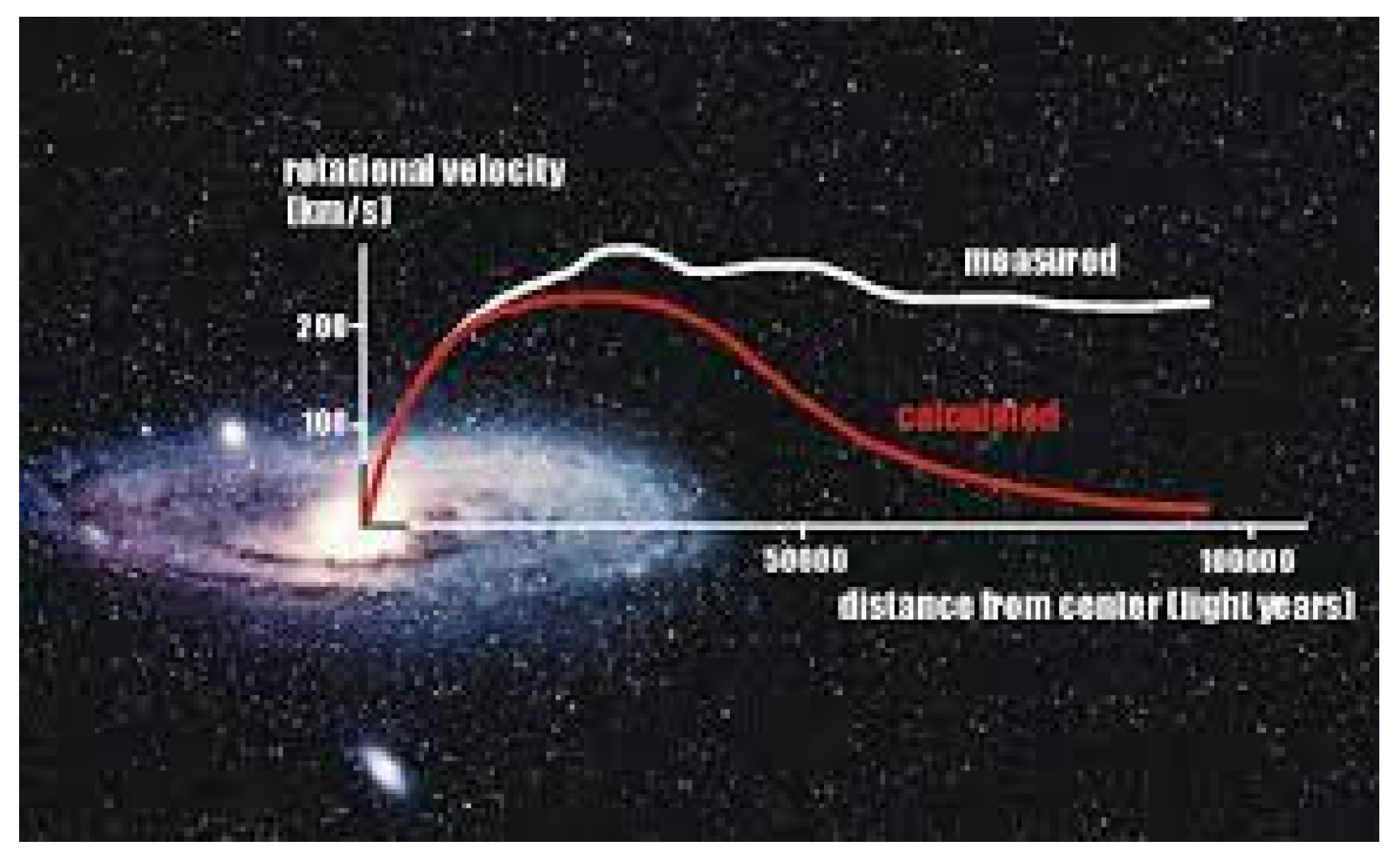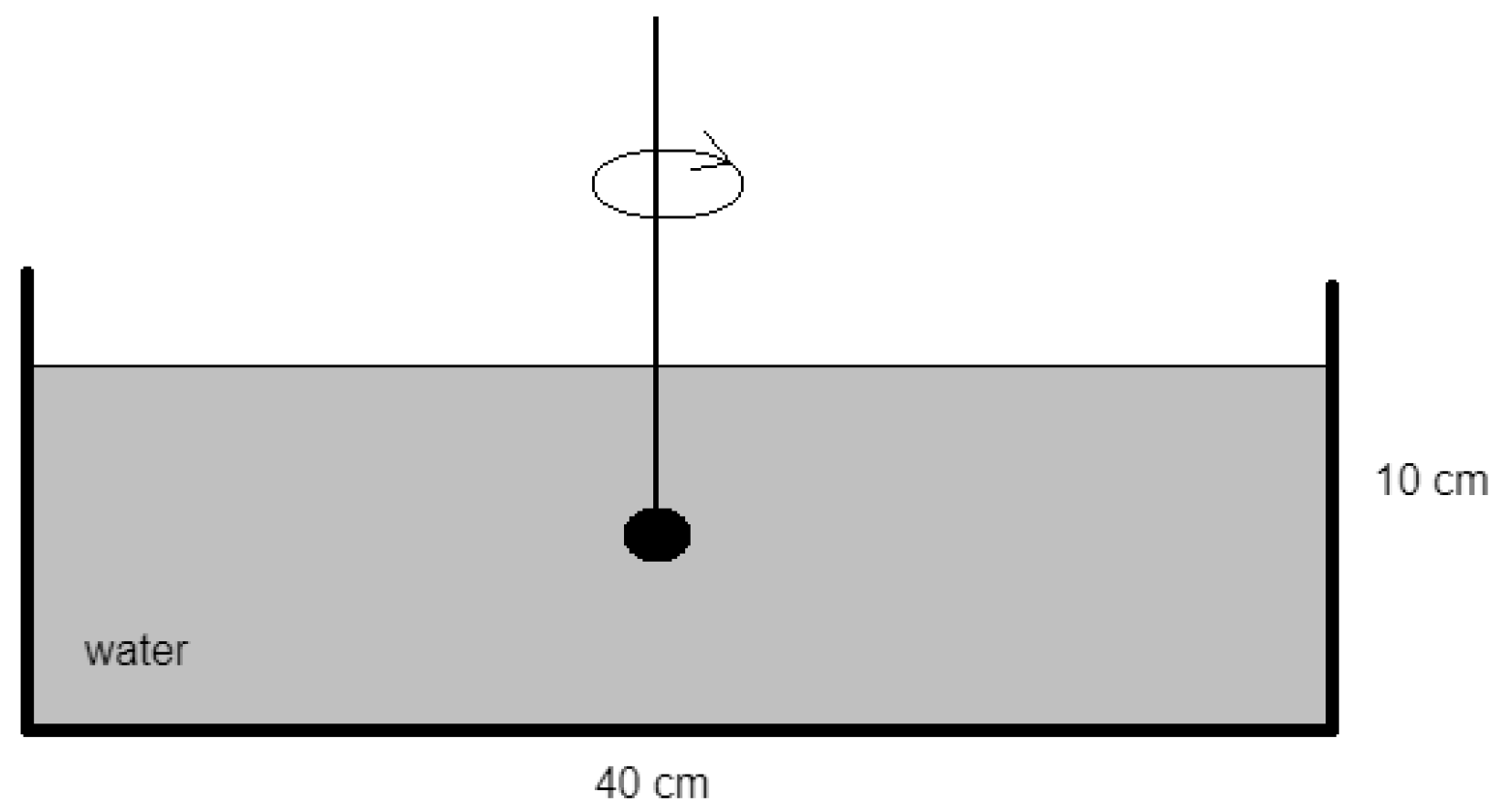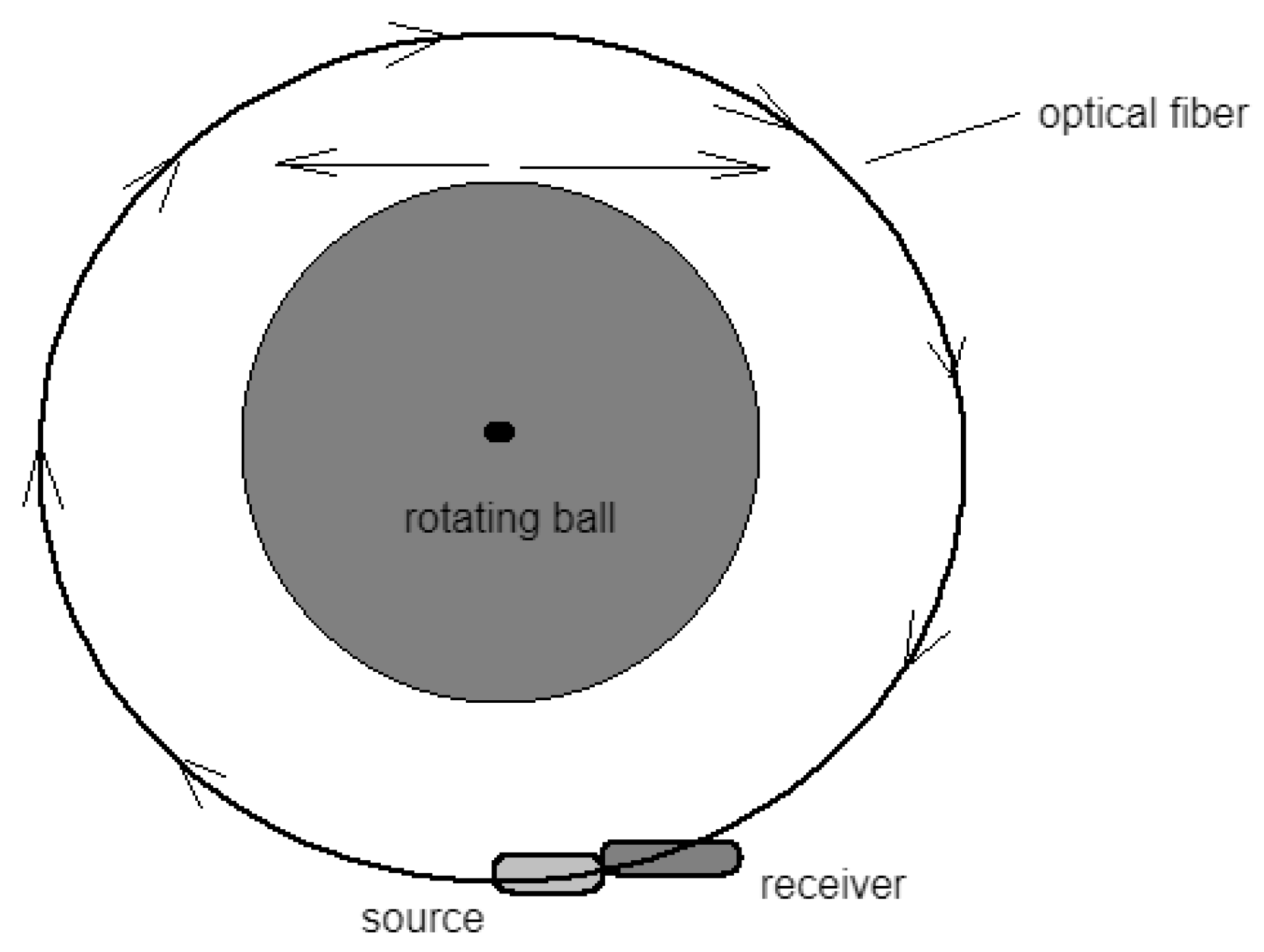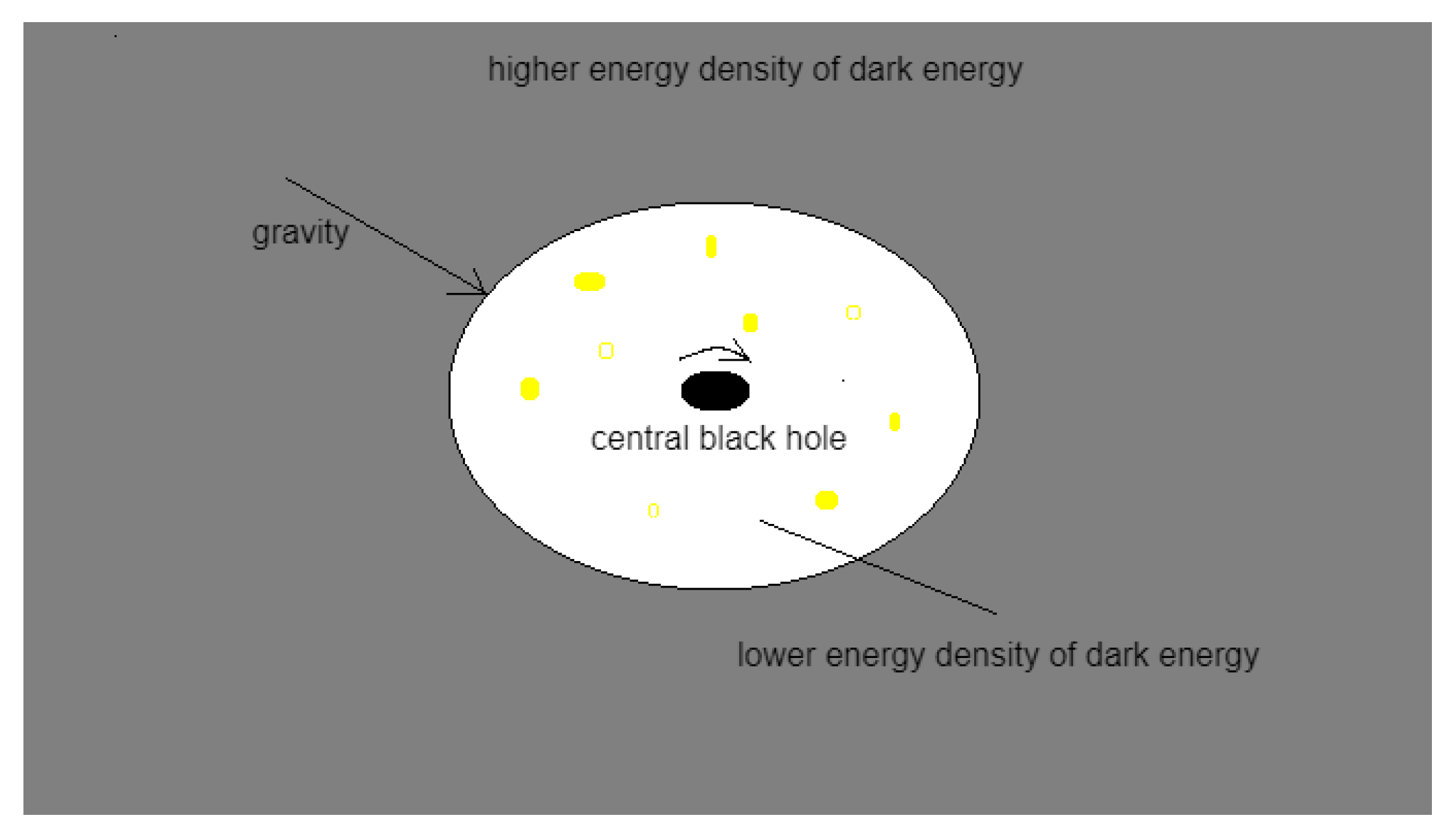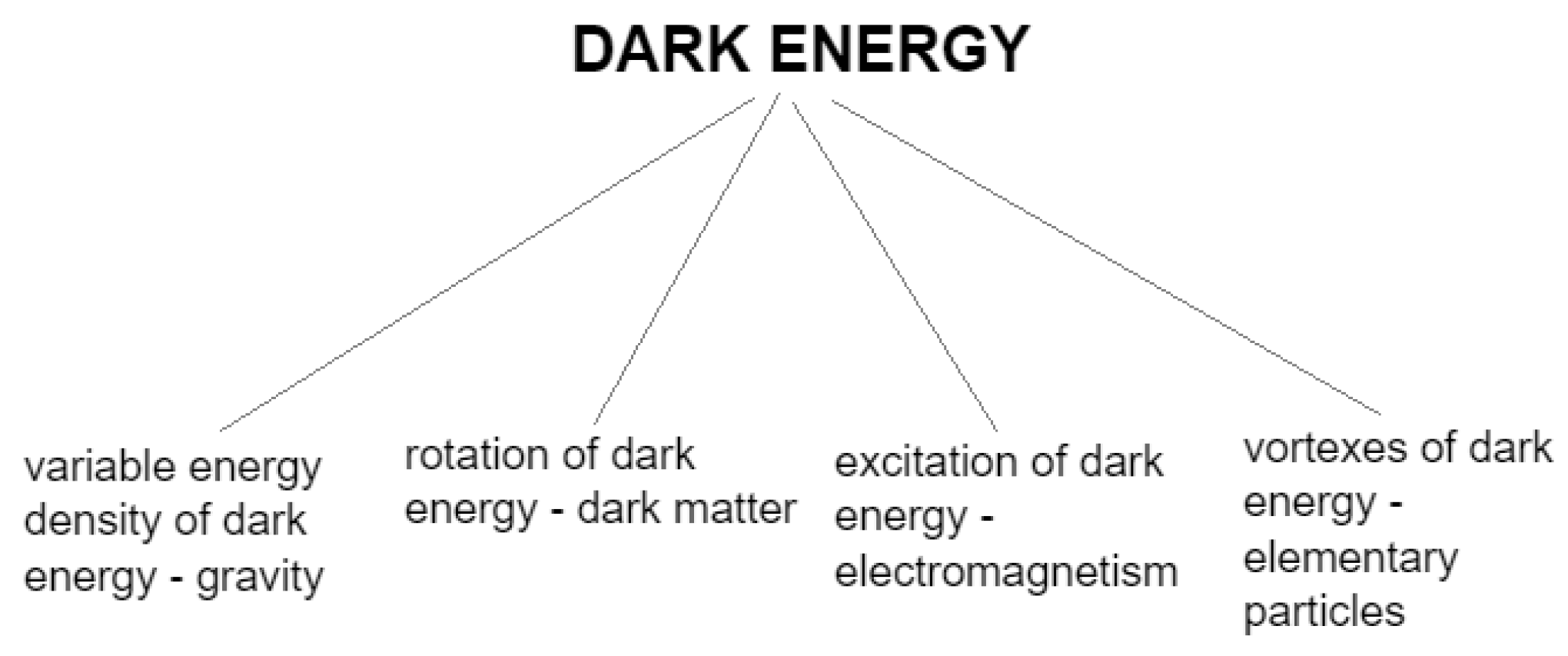1. Introduction
In our solar system, the rotational velocity of
planets is diminishing with the distance from the Sun. This was also expected
by the stars that are rotating around the SMBHs in the center of spiral
galaxies. Zwicky discovered back in 1930-40 that this is not the case. The
measured orbital velocity of stars that are further away from the central SMBHs
is not declining as supposed by laws of motion and gravity (see Figure 1 below). Back in 1930-40 Zwicky
proposed the existence of hidden dark matter in the galaxies. This hypothetical
dark matter should increase gravity and should be the cause of measured orbital
velocities of stars [1,2].
Figure 1.
Orbital velocities of stars.
Figure 1.
Orbital velocities of stars.
After 80 years of intense search dark matter was
not discovered yet [3,4]. Some physicists
suggested that dark matter is non-existent and that we should modify our models
of gravity [5]. In this article, the third
solution is proposed: the model of gravity is correct, and the physical origin
of stars’ orbital velocity is rotating dark energy.
2. Rotating Dark Energy
Orbital time of a star that is orbiting around the
central black hole of a given galaxy we calculate as follows:
where r is the distance from the central black
hole, G is the gravitational constant and m is the mass of the central black
hole. SMBHs are rotating around their axis with a high angular velocity which
generates relativistic mass
[6]. Relativistic
mass is causing the orbital velocity of stars to be higher than the calculated
orbital velocity in the frame of Newtonian physics. Equation (1) is transformed
into the equation below:
We calculate the orbital velocity of a given star
as follows:
where d is the length of its orbit. The orbital velocity
of dark energy that surrounds a given star we calculate as follows:
where
is the angular velocity of dark energy in the
star’s orbit and r is the radius of the star’s orbit. The total orbital
velocity of the star is the sum of its relativistic orbital velocity and the
orbital velocity of dark energy:
The angular velocity of rotating dark energy
depends on the age of the galaxy. The older galaxy bigger the angular velocity
of dark energy. In the formation of a galaxy, when the central black hole
starts rotating over time also dark energy starts rotating. The orbital velocity of dark energy around the central
black hole of a galaxy is the biggest near the black hole and appears there
first. By time also areas of more distant dark energy start orbiting around the
central black hole. The older galaxy higher the orbital velocity in distant
areas.
Mercury’s precession is 43 arcseconds in 100 years,
and its orbiting time is 88 days. In one orbiting period, this is 29 km, which
in 100 years is 12028 km [7]. We calculate the
orbital velocity of the dark energy on Mercury’s orbit as follows:
where
= 29000 m, and orbital time
= 88 days.
The orbital velocity of dark energy on the Mercury orbit is 3.81 millimeters per second. The orbital velocities of dark energy on the orbits of stars circulating around centers of spiral galaxies are much bigger than in the solar system because galaxies are much older than the solar system. The Milky Way galaxy is old about
years. The solar system is old about years. That’s why the impact of the rotating dark
energy on the planet’s precession is small in comparison to the impact of dark
energy rotation on the stars that rotate around the central black hole of Milky
Way, Sagittarius . Einstein’s calculation of Mercury’s precession is right, but it does not explain its physical cause which is the motion of dark energy in Mercury’s orbit.
3. Experimental Proof for Rotating Dark Energy
The idea that universal space is a kind of superfluid liquid is entering the mainstream of physics [8,9]. Imagine that you put a wooden ball in the water. When you start the rotation of the ball at the beginning only the water that is near the ball starts rotating. By the time also water that is farther from the ball will rotate. The experiment was done using a round steel bawl diameter of 40 cm filled with 10 cm of water. In the center of the bawl a wooden ball with a diameter of 3 cm was placed. The ball was fixed on the axis of the motor that was switched on. The angular velocity of the wooden ball was . It took 56 seconds, and also the water that was 20 cm far from the center of the wooden ball was rotating with the angular velocity .
Figure 2.
Increased angular velocity of water.
Figure 2.
Increased angular velocity of water.
In this article dark energy is presented as a kind of superfluid that is the physical origin of universal space. In spiral galaxies, the angular velocity of dark energy is increasing over time and increases the observed orbital velocities of stars that are orbiting around the central black holes.
The second experimental proposal for the rotation of dark energy around rotating physical objects is the following: we have the source of light and detector of light that are connected by round optical fiber. Inside the optical fiber circle, we have a metal ball that we can rotate clockwise and anticlockwise.
Figure 3.
Doppler effect and rotating dark energy.
Figure 3.
Doppler effect and rotating dark energy.
When the ball is still, the detector will detect a given frequency of light. When the ball will rotate with a high angular velocity in a clockwise direction, the frequency of light will increase. The motion of the medium will add energy to the photon and so the light will gain frequency. When the ball will rotate in an anticlockwise direction, the frequency of light will decrease. The motion of the medium will take away the energy of the photons and their frequency will diminish. In the proposed experiment in
Figure 3 rotation of dark energy (superfluid space) around the rotating objects should be proved directly by the change of light frequencies.
The physical origin of the light frequency change by the Doppler effect is the kinetic energy of the moving source. Imagine you are on a bicycle that is still and you throw the ball. Then you ride the bicycle, and you throw the ball with the same force. This ball will have bigger kinetic energy than the ball that was thrown from the bicycle at rest: a ball that was thrown from the bicycle at rest has a kinetic energy , where is the mass of the ball and is the velocity of the ball. A ball that was thrown from the moving bicycle has a kinetic energy )/2, where is the velocity of the ball and is the velocity of the bicycle. When you ride a bicycle with velocity and you throw the ball in the direction opposite to motion, the kinetic energy of the ball will be . The same happens with the photon. When a photon is produced in the source that is moving in the direction of photon motion, the kinetic energy of the source is increasing the kinetic energy of the photon and so the photon got a higher frequency. When a photon is produced in the source that is moving in the opposite direction of photon motion, the kinetic energy of the source is decreasing the kinetic energy of the photon and the photon got a lower frequency. This is happening because dark energy (superfluid space) around the source is moving with the source. Photon is the excitation of dark energy. When dark energy is moving in the direction of photons’ motion, it increases its frequency. When dark energy is moving in the opposite direction of photons’ motion, it decreases their frequency. The source of light is activating the virtual photons that are in the superfluid space. Photons are not created in the source of the light, the source only activates virtual photons that are present in the entire universal space [10]. When the source of light is moving in the space also surrounding space is moving with the source. This space in motion (superfluid in motion) will add or diminish the frequency of the photon.
The impact of rotating superfluid space (dark energy) on the frequency of light was already indirectly proved by French physicist Sagnac. When his interferometer is rotating, the light beam that moves in the direction of interferometer rotation will increase frequency. The light beam that moves in the opposite direction of interferometer rotation will decrease frequency. In Sagnac’s experiment, the change in frequency of light beams is changing the interference pattern. If we rotated a metal ball inside the still interferometer, we would get a similar result as when the interferometer is rotating. In both cases, the dark energy starts rotating and this is changing the light frequency.
4. Discussion
We have to overcome the idea that the universal space exists on its own and is filled with dark energy. The fact is that dark energy is the physical origin of the universal space. The idea of an “empty space” in which dark energy exists is false. This “empty space” is “dark energy”. Galaxies and stars are moving in dark energy. Seeing the universe from this perspective gives us a more realistic picture. The Lense-Thirring effect [11] is the effect of dark energy rotation around a stellar object that rotates around its axis. This effect is causing the precession of planets in our solar system and is causing the additional orbital velocity of stars that are orbiting central black holes of spiral galaxies.
Gravity as a consequence of space curvature is a mathematical model that can be replaced by gravity as the vector of space that points from the higher energy density of dark energy to the lower energy density of dark energy. The vector model of gravity is a physical model, it explains the physical origin of gravity; every physical object is diminishing the energy density of dark energy exactly for the amount of its mass and energy. This is the extension of the mass-energy equivalence principle on dark energy which is the physical origin of superfluid space:
where m is the mass of the object, V is the volume of the object,
is the Planck energy density of dark energy in interstellar space and
is the energy density of dark energy in the center of the physical object. Gravity is immediate and has no carrier, gravity is embedded in the variable energy density of dark energy [12]. There is no direct gravitational force between stellar objects. The area of the higher energy density of dark energy around the galaxy is pushing towards the central black hole where the energy density of dark energy is at the minimum. This difference in energy density of dark energy generates gravity.
Figure 4.
Difference in energy density of dark energy generates gravity.
Figure 4.
Difference in energy density of dark energy generates gravity.
This model of gravity works well from the macro scale (galaxy) to the micro scale (proton) without the hypothetical graviton. Dark energy, also named “superfluid space” is a four-dimensional type of energy in which three-dimensional physical objects are caught [13]. There-dimensional mass is diminishing the four-dimensional energy density of dark energy which is generating gravity.
From the historical perspective, at the beginning of the 20th century, mathematical physics overruled experimental physics. In special relativity, time is introduced as a 4th physical dimension of space without having experimental data confirming this model. The Lens-Thirring effect today is still seen as a frame-dragging effect of space-time [14]. Time is the duration of an object's motion in space. Duration enters existence when being measured by the observer. Time is an emergent physical quantity created when an observer compares the rate (motion) of a clock with the motion of the physical object in space. There is no physical time in space [15]. The Lens-Thirring effect is the displacement of space. Space rotates with the rotating stellar objects. Space is a type of energy, the idea of “empty space” having only geometrical properties and being deprived of physical properties is from the phenomenological point of view weakening of physics. This is the weak point of general relativity that can be improved by substituting the curvature of space with the variable energy density of space, as it is presented in Equation (6). All phenomena of general relativity can be described by the variable energy density of space [16]. General relativity is a successful mathematical theory with the leak of physical meaning. Substituting the curvature of space with the variable energy density of space, physical meaning is achieved. The more space is curved, the lesser its energy density. The variable density of space carries gravity.
The proposal of this article that dark energy is the energy of space makes sense because “empty space” cannot exist. Space is not filled with dark energy, space itself is dark energy. Seeing space as a superfluid it is obvious that rotating stellar objects will also rotate dark energy. Might be that at first sight, this looks “too simple” but it has physical meaning. If Zwicky had such a view, he would not predict the existence of dark matter.
In the model presented in this article, we have 5% energy in the form of ordinary matter in the universe and 95% in the form of dark energy. The challenge of physics is to search if ordinary matter can be seen as a form of dark energy. Here seems the right direction to reach the grand unification theory. Dark matter is seen as a primordial energy field of the universe, and elementary particles as different excitations of this primordial field. In this vision, Big Bang cosmology as one big explosion before time and expansion forever is not appropriate anymore, because the universe is a timeless phenomenon. “The beginning” of the universe is the wrong question, the right question is “how does the universe work?” The crucial question is: “What happens in the centers of SMBHs”? Central black holes are creating huge jets made out of elementary particles. From where do these particles come?
Jets are well documented and still today we do not know how they are created [17]. Jets are an essential part of a deeper understanding of spiral galaxies. Orbital velocities of stars are an essential part of a deeper understanding of spiral galaxies. Development of the model that will explain both phenomena would be good progress.
Dark energy as the fundamental primordial field of the universe excludes the possibility of singularities in the universe. “Infinite pressure”, infinite temperature” in the first moment of the big bang have no physical meaning. Also, “infinite gravity” in the center of SMBHs has no physical meaning. Infinities are the result of a century-long mathematical supremacy over physics. SMBHs without gravitational singularities are closer to the physical way of seeing because if we predict gravitational singularity in a centre of SMBH then we have to calculate how this singularity is diminishing by the distance The problem seems unsolvable. In the centre of SMBHs energy density of dark energy diminishes but it is not coming close to zero. With Equation (6) we calculated the value of energy density in the centre of a black hole Cygnus X-1, in the centre of a black hole GRS 1915+105, in the centre of a black hole ASASSN-14li, in the centre of the Sun, in the centre of the Earth:
In the centre of Cygnus X-1 if it would not rotate energy density of dark energy is: . In the centre of Cygnus X-1 adding its relativistic energy because of its rotation, the energy density of dark energy is: . Cygnus rotates 800 times per second, which means that the angular velocity of Cygnus X-1 is 5026 .
In the centre of GRS 1915+105 if it would not rotate energy density of dark energy is: . In the centre of GRS 1915+105 adding its relativistic energy because of its rotation: . GRS 1915+105 black hole rotates 1150 times per second, which means the angular velocity of GRS 1915+105 is 7225 .
In the centre of ASASSN-14li if it would not rotate energy density of dark energy is: . In the centre of ASASSN-14li adding its relativistic energy: . ASASSN–14li black hole rotates 1 time in 120 seconds, which means the angular velocity of ASASSN–14li is 0,0524 .
In the centre of the Sun energy density of dark energy calculation when at the rest and rotating is giving the same result: In the centre of the Earth energy density of dark energy calculation when at the rest and rotating is giving the same result: [6].
We see that the energy density of dark energy in the black hole ASASSN-14li is smaller than in the centre of the Sun. Here is the possible explanation for jets, it might be that in the centre of SMBHs energy density of dark energy is so low that atoms become unstable. They fall apart into elementary particles that form huge jets. In this perspective SMBHs are the rejuvenating systems of the universe, they transform old matter into fresh energy in the form of jests [18]. Sbitnev has developed a model where elementary particles are different vortexes of superfluid quantum space [19] that here is understood as dark energy. Elementary particles that build atoms are different vortexes of dark energy. When the energy density of dark energy is too low, atoms become unstable because the diminished energy density of dark energy changes the electromagnetic forces between electrons and protons.
The value of energy density of dark energy in the centre of the proton is which is lower than in the centre of ASASSN-14li. Hawking has predicted that a proton could be a mini black hole [20]. Seeing the proton as a vortex of dark energy is comparable with the SMBH that is taking in the old matter and transforming it into fresh energy in the form of jets. Also, a proton could be a vortex of dark energy, taking in at the equator and throwing it out at the poles. Recently an article was published with the mathematical model of the point vortex model [21]. Further research in this direction could give us promising results in unified field theory as well as in cosmology.
Figure 5.
Dark energy unified field theory.
Figure 5.
Dark energy unified field theory.
Erwin Schrödinger's view: "What we observe as material bodies and forces are nothing but shapes and variations in the structure of space", is offering the development of physics with unexpected results.
5. Conclusions
With the right understanding of the Lens-Thirring effect, we can elegantly describe the additional orbital velocity of stars orbiting around the central black holes of spiral galaxies. There is no need to introduce dark matter, and there is no need to introduce modified theories of gravity. The Lens-Thirring effect is the effect of rotational dark energy around the stellar objects that are rotating around their axis. Also, Mercury's precession is caused by the rotational dark energy in its orbit.
References
- Barbarina Zwicky et al, Fritz Zwicky and the earliest prediction of dark matter, Phys. World 34 (5) 24 (2021). https://iopscience.iop.org/article/10.1088/2058-7058/34/05/28.
- de Swart, J., Bertone, G. & van Dongen, J. How dark matter came to matter. Nat Astron 1, 0059 (2017). [CrossRef]
- Elena Asencio, Indranil Banik, Steffen Mieske, Aku Venhola, Pavel Kroupa, Hongsheng Zhao, The distribution and morphologies of Fornax Cluster dwarf galaxies suggest they lack dark matter, Monthly Notices of the Royal Astronomical Society, Volume 515, Issue 2, September 2022, Pages 2981–3013. [CrossRef]
- Gibney E. Last chance for WIMPs: physicists launch all-out hunt for dark-matter candidate. Nature. 2020 Oct; 586 (7829):344-345. https://www.nature.com/articles/d41586-020-02741-3.
- McGaughStacy S.. A tale of two paradigms: the mutual incommensurability of ΛCDM and MOND. Canadian Journal of Physics. 93(2): 250-259. [CrossRef]
- Niko Gorjup, Amrit Sorli, SMBH Relativistic Mass and Missing Dark Matter, Advanced Studies of Theoretical Physics, Vol. 16, 2022, no. 4, 291-29. [CrossRef]
- Michael Seeds, Dana Backman, Foundations of Astronomy, Cengage Learning, Boston, USA (2911) ISBN 13: 978-1-305-07915-1.
- Liberati S, Maccione L. Astrophysical constraints on Planck scale dissipative phenomena. Phys Rev Lett. 2014 Apr 18;112(15):151301. [CrossRef]
- Moskowitz, C. ‘Superfluid spacetime’ points to unification of physics. Nature (2014). [CrossRef]
- Fiscaletti D., Sorli A., A Three-Dimensional Non-Local Quantum Vacuum as the Origin of Photons, Ukr.J.Phys. 65 (2020) 2, 106 (2020). [CrossRef]
- Pfister, H. On the history of the so-called Lense-Thirring effect. Gen Relativ Gravit 39, 1735–1748 (2007). [CrossRef]
- Niko Gorjup, Amrit Sorli, Vector model of gravity, Advanced Studies in Theoretical Physics, Vol. 16, 2022, no. 4, 281-289. [CrossRef]
- Šorli, A.S. & Čelan Š., Time-Invariant Superfluid Quantum Space as the Unified Field Theory, RAPS, Vol. 4, No. 3 (2020) 2050007. [CrossRef]
- Everitt CW, DeBra DB, Parkinson BW, Turneaure JP, Conklin JW, Heifetz MI, Keiser GM, Silbergleit AS, Holmes T, Kolodziejczak J, Al-Meshari M, Mester JC, Muhlfelder B, Solomonik VG, Stahl K, Worden PW Jr, Bencze W, Buchman S, Clarke B, Al-Jadaan A, Al-Jibreen H, Li J, Lipa JA, Lockhart JM, Al-Suwaidan B, Taber M, Wang S. Gravity Probe B: final results of a space experiment to test general relativity. Phys Rev Lett. 2011 Jun 3;106(22):221101. [CrossRef]
- Šorli A., Čelan Š., Time as the result of the observer measurement, Physics Essays, 34, 4 (2021). [CrossRef]
- Šorli A. and Štefan Č. Advances of Relativity, Physics essays 34, 2 (2021). [CrossRef]
- Roger Blandford, David Meier, Anthony Readhead, Relativistic Jets from Active Galactic Nuclei, Annual Review of Astronomy and Astrophysics 2019 57:1, 467-509. https://www.annualreviews.org/doi/10.1146/annurev-astro-081817-051948.
- Amrit S. Sorli, Stefan Celan, Niko Gorjup, Physical Aspects of Penrose’s Black Hole Singularities, Advanced Studies in Theoretical Physics Vol. 16, 2022, no. 4, 191 – 200. [CrossRef]
- Sbitnev, V.I. Hydrodynamics of the Physical Vacuum: II. Vorticity Dynamics. Found Phys 46, 1238–1252 (2016). [CrossRef]
- Hawking, S. W., Gravitationally collapsed objects of very low mass, MNRAS 152 (1971), 75-78. [CrossRef]
- Jonathan Skipp, Jason Laurie, Sergey Nazarenko, Hamiltonian derivation of the point vortex model from the two-dimensional nonlinear Schrödinger equation (2022). [CrossRef]
|
Disclaimer/Publisher’s Note: The statements, opinions and data contained in all publications are solely those of the individual author(s) and contributor(s) and not of MDPI and/or the editor(s). MDPI and/or the editor(s) disclaim responsibility for any injury to people or property resulting from any ideas, methods, instructions or products referred to in the content. |
© 2023 by the authors. Licensee MDPI, Basel, Switzerland. This article is an open access article distributed under the terms and conditions of the Creative Commons Attribution (CC BY) license (http://creativecommons.org/licenses/by/4.0/).
